天体分光学
表示

天体分光学︵てんたいぶんこうがく、英語: Astronomical spectroscopy︶は、恒星やその他の天体から放射された電磁波︵可視光線・赤外線・紫外線・X線・電波など︶のスペクトルを測定する分光学の技術を用いた、天文学における研究分野や技法を指す[1]。恒星のスペクトルは、その星の大きさや質量・密度、温度、光度や距離、化学組成といった多くの特性を反映している。分光を用いてドップラーシフトを測定することで、視線速度と呼ばれる天体が観測者の方へ向かってくる・または観測者から遠ざかる速度を測定することもできる。分光を用いて、恒星以外にも星雲・惑星・活動銀河核といった様々な種類の天体の物理特性の研究が行われている。
背景
[編集]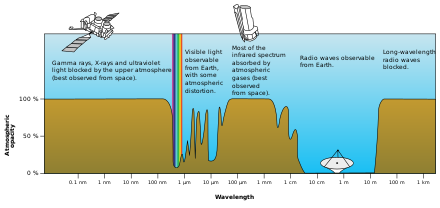
天体分光学の形態は、電磁波の波長帯によって可視光やその前後の紫外線・赤外線を分光する光学的分光、電波分光、X線分光の3種類に分けられる。どの分光法もスペクトル中の特定の波長域帯を観測するが、その波長によってスペクトルを得るための具体的手法が異なる。
オゾン (O3) や酸素分子 (O2) は波長300 nm以下の光を吸収するため、X線や紫外線の分光には宇宙望遠鏡や観測ロケットを要する[2]:27。
電波信号は光学的信号よりもずっと波長が長いため、電波望遠鏡を使用する必要がある。赤外線は波長によっては大気中の水分子や二酸化炭素分子による吸収を受ける部分があるため、通常の地上における光学的分光を用いるよりも宇宙望遠鏡から観測したほうがより多くの赤外スペクトルを取得できる[3]。
光学的分光学
[編集]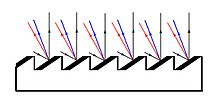
アイザック・ニュートンが最初に簡単なプリズムを用いて太陽のスペクトルを観察して以来、物理学者は太陽のスペクトルを長年観測してきた[4]。1800年代初めには、ヨゼフ・フォン・フラウンホーファーがガラス職人としての自身の技術を駆使して作り上げた超高純度なプリズムを使い、太陽の連続スペクトル中に574本の暗線を発見し、これらはフラウンホーファー線と呼ばれた[5]。直後から彼は、望遠鏡とプリズムを組み合わせた装置を用いて月や金星、火星といった惑星、さらにベテルギウスをはじめ多くの恒星のスペクトルを観測した。フラウンホーファーの死後も彼の会社は1884年に閉鎖されるまで、彼独自の設計による高品質な屈折望遠鏡の生産・販売を続けた[6]:28–29。
プリズムの波長分解能はそのサイズによって決まり、大きなプリズムほど詳細なスペクトルが得られるも、それだけ大きなガラス塊になると重量も増大し、細かな観測作業において不便となる[7]。
この問題は1900年代初頭に入って、カナダ・オタワにあったドミニオン天文台のジョン・スタンリー・プラスケットが、グレーティングとも呼ばれる高品質な回折格子を開発したことで解決された[6]:11。回折格子上の鏡で光はどの波長でも同じ角度で入射するが、一部の光は異なる角度で屈折を起こす。この角度は鏡の材料の屈折率と光の波長に依存する[8]。多数の平行鏡を利用するブレーズド回折格子を作ることで、光のごく一部を集光して可視化できる。この新しい分光器はプリズムよりも詳細なスペクトルを得ることができ、測定に要する光量もプリズムより少なく、グレーティングを傾けることで分光する波長帯を容易に調整できる点で優れている[7]。
ブレーズド回折格子の分光限界は鏡の幅で決まり、ブレーズを入れる幅が1000本/mmを超えるとピントが合わなくなる。この限界を超えるためにホログラフィックグレーティングが開発された。体積位相ホログラフィックグレーティングはガラス表面にニクロム化ゼラチンを塗布し、干渉計で生成した干渉パターンを照射することで作られる。このパターンはブレーズド回折格子に似ているが、実際はブラッグ回折を用いており、反射角はゼラチンの原子配置に依存する。
原子レベルの微細加工によりホログラフィックグレーティングでは6000本/mmの格子を入れることができ、集光効率も2倍ほど改善している。2枚のガラスの間に密閉されているためホログラフィックグレーティングの用途は広く、交換せずに数十年間使い続けることもできる[9]。
分光器の中のプリズムやグレーティングによって分散させられた光は検出器によってそれぞれの波長位置で検出される。歴史的に、電子的な装置が開発されるまでは写真乾板が広く使われてきたが、今日の光学分光器ではCCDイメージセンサに置き換わっている[10]。
スペクトル波長はガス封入管からの既知波長のスペクトル線で較正できる。スペクトルごとのフラックス密度のスケールは、大気吸収を補正した標準星の観測結果から波長関数として較正でき、これは分光測色法として知られている。
電波分光学
[編集]
電波天文学は1930年代初頭に、ベル研究所のカール・ジャンスキーによって始祖された。彼は大西洋間無線通信において電波干渉を起こしうる電波源を探すためのアンテナを設置していたところ、地球上からではなくいて座の天の川中心からのノイズを検出した[11]。1942年には、軍用レーダーの受信機を使ってジェームズ・ヘイが太陽電波を観測した[2]:26。
電波分光学は、1951年に中性水素の21cm線が観測されたことから始まった。
電波干渉法
[編集]
電波干渉法は1946年にジョセフ・L・ポージー、ルビー・ペイン=スコット、リンゼイ・マクレディーが海食崖の上に設置した1基のアンテナで200 MHzの太陽電波を観測したことから始まる。この観測でアンテナに入射した電波は2種類あり、1つは太陽から直接届いた電波で、もう1つは海面で反射した太陽電波で、これらが干渉を起こしていた[12]。
マーティン・ライルとデレク・ボンバーグによって複数の受信機による干渉計が最初に開発されたのも同年である[13][14]。ライルとアントニー・ヒューイッシュはこの技術をもとに、1960年に干渉計のデータ解析手法である開口合成を発表した[15]。この手法では入力信号に対して自己相関と離散フーリエ変換を用いることによって、フラックスの空間変動と周波数変動を回復させる[16]。その結果、3番目の軸として周波数が加わったデータキューブが生成され、その空間分解能は複数のアンテナ間の距離と同じだけの口径を持った超巨大アンテナと同等にまでなる。
この業績に対して、ライルとヒューイッシュは1974年にノーベル物理学賞を受賞した[17]。
X線分光学
[編集]詳細は「X線天文学」を参照
天体からのX線を捉える検出器は、その原理上検出したX線光子1個1個のエネルギー︵周波数・波長に相当︶の情報を同時に得ることができる。そのため、X線の観測は常に分光学的である。ただし、観測の内容によっては得られた波長の情報を解析段階で破棄して処理することもある[18]。
恒星とその特性
[編集]化学組成
[編集]
ニュートンはプリズムを用いて太陽からの白色光を色のついたスペクトルに分解し、フラウンホーファーは高品質なプリズムで、そのスペクトル中に未知の起源をもつ暗線を発見した。1850年代になり、ロベルト・ブンゼンとグスタフ・キルヒホフによってこの暗線の正体が解明された。
その正体として、まず高温の物体は連続スペクトルを持つ光を放射し、高温のガスは特定の波長の輝線と呼ばれる光を放つ。この高温物体が、それより低温なガスに包まれていると、そのスペクトルは一見すると元の連続スペクトルに見えるが、ところどころに暗線が見られ、暗線が現れる波長はそのガスが放つ輝線の波長と一致する[6]:42–44[19]。これにより、太陽スペクトル中の吸収線を、地上の実験室によって同定されている既知のガスの輝線と比較することで、太陽の化学組成を知ることができる。これは他の恒星にも応用できる。
有名なフラウンホーファー線として以下の表中のものが知られており、関連付けられている元素とともに示す。︵︶内は初期のバルマー系列で呼ばれていた線の呼称である。
|
|
太陽のすべての元素がすぐに吸収線から特定されたわけではない。例として、
●1868年に、ノーマン・ロッキャーとピエール・ジャンサンがナトリウムの二重スペクトルの隣に、当時発見されていた元素輝線では同定できないスペクトルを独立して発見し、ロッキャーはこの吸収線を新元素によるものと判断しヘリウムと名付けた。しかしヘリウムが地上で発見され、輝線が同定されたのは1895年になってからだった[6]:84–85。
●天文学者のウィリアム・ハークネスとチャールズ・ヤングは1869年8月7日の日食︵皆既日食︶中に太陽コロナ中に緑色の輝線を独立して発見した。これは新元素によるものと誤認され、コロナ中にしか見られないことからコロニウムと名付けられた。その後、ヴァルター・グロートリアンとベングト・エドレンによってこの波長530.3 nmの輝線源が、Fe13+という鉄から13個もの電子が失われたイオンによるものだと判明したのは1930年代に入ってからだった[20]。他にもコロナのスペクトルからはニッケルやカルシウムなどがコロナの高温によって多くの電子を失ったイオンが見つかっており、通常見られないような極端な輝線が存在している[2]:87,297。
現在太陽スペクトル中には2万本以上の吸収線が波長293.5 nmから 877.0 nmの範囲で発見されているが、どの元素による吸収かが同定されているのはそのうち75%ほどに過ぎない[2]:69。
スペクトル中の輝線のそれぞれの幅を解析することで、その天体にそれぞれの元素が存在することだけでなく、その相対存在量も決定できる[8]。この情報を用いて恒星を金属量で分類することができ、この分類で種族Iと呼ばれる星は若い星が多く高い金属量を示す太陽もこの種族に属する︶。逆に種族IIIと呼ばれる星は宇宙の最初期に誕生した最も古い恒星で、極めて低い金属量を示すが直接観測されたことはなく候補天体があるのみである[21][22]。
温度と大きさ
[編集]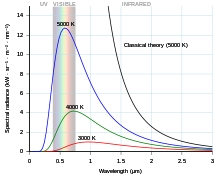
1860年、グスタフ・キルヒホフは黒体放射の考えを提唱し、物体はみな温度に応じた波長分布に従い、全波長で電磁波を放射しているという考え方を示した[23][24]。1894年にはヴィルヘルム・ヴィーンが、物体の温度︵T︶とそこから放たれる黒体放射のピーク波長︵λmax︶を関連付ける定式を導出した[25]。
 bは比例定数で、2.897 771 955 ... × 10-3 m·Kという値をとる。この式はウィーンの変位則と呼ばれており、これを利用して天体のスペクトルのピーク波長を測定することで、その天体の表面温度を決定できる[19]。例えば、ピーク波長が502 nmの恒星の表面温度は5778Kとなる。
また、天体の光度は一定時間に放出される天体からの放射エネルギーの尺度である[26]。光度をLとおくと星の温度と次のように定式化できる。
bは比例定数で、2.897 771 955 ... × 10-3 m·Kという値をとる。この式はウィーンの変位則と呼ばれており、これを利用して天体のスペクトルのピーク波長を測定することで、その天体の表面温度を決定できる[19]。例えば、ピーク波長が502 nmの恒星の表面温度は5778Kとなる。
また、天体の光度は一定時間に放出される天体からの放射エネルギーの尺度である[26]。光度をLとおくと星の温度と次のように定式化できる。
 Rは天体の半径、σ はシュテファン=ボルツマン定数で5.670 374 419 ... × 10-8W・m-2・K-4という値をとる。したがって光度と温度の両方が分かっていれば、天体の大きさも決定される。
Rは天体の半径、σ はシュテファン=ボルツマン定数で5.670 374 419 ... × 10-8W・m-2・K-4という値をとる。したがって光度と温度の両方が分かっていれば、天体の大きさも決定される。
 bは比例定数で、2.897 771 955 ... × 10-3 m·Kという値をとる。この式はウィーンの変位則と呼ばれており、これを利用して天体のスペクトルのピーク波長を測定することで、その天体の表面温度を決定できる[19]。例えば、ピーク波長が502 nmの恒星の表面温度は5778Kとなる。
また、天体の光度は一定時間に放出される天体からの放射エネルギーの尺度である[26]。光度をLとおくと星の温度と次のように定式化できる。
bは比例定数で、2.897 771 955 ... × 10-3 m·Kという値をとる。この式はウィーンの変位則と呼ばれており、これを利用して天体のスペクトルのピーク波長を測定することで、その天体の表面温度を決定できる[19]。例えば、ピーク波長が502 nmの恒星の表面温度は5778Kとなる。
また、天体の光度は一定時間に放出される天体からの放射エネルギーの尺度である[26]。光度をLとおくと星の温度と次のように定式化できる。
 Rは天体の半径、σ はシュテファン=ボルツマン定数で5.670 374 419 ... × 10-8W・m-2・K-4という値をとる。したがって光度と温度の両方が分かっていれば、天体の大きさも決定される。
Rは天体の半径、σ はシュテファン=ボルツマン定数で5.670 374 419 ... × 10-8W・m-2・K-4という値をとる。したがって光度と温度の両方が分かっていれば、天体の大きさも決定される。
銀河
[編集]
銀河のスペクトルは、何十億個もの恒星のスペクトルが組み合わさった結果なので、恒星に似たスペクトルを示す。
1937年にフリッツ・ツビッキーが行った銀河団のドップラーシフトの研究では、可視光から予想される銀河団の質量から推定される速度よりもずっと高速で銀河団が移動していることが分かった。ツビッキーは、銀河団の中には光を放っていない物質が大量に存在していると仮説を立て、それが暗黒物質として今日まで知られている[27]。
ツビッキーの発見以降、天文学者は銀河の大部分・さらには宇宙の大部分が暗黒物質に占められていることを見出した。しかし、2003年にはM105、NGC 821、NGC 4494、NGC 4697の4銀河を構成する恒星の動きに暗黒物質による影響がほとんど無いことが分かり、この原因もまた不明である[28]。
1950年代に、強い電波を放つ電波源がとても暗く赤い天体に同定された。これらの天体のうちの1つを分光観測した結果、予想される位置と異なる位置に吸収線が見られた。この奇妙なスペクトルは、間もなく通常の銀河のスペクトルが大きく赤方偏移したものだと分かった[29][30]。これらは1964年に天文学者ホン・イェー・チューに準恒星状電波源︵英:quasi-stellar radio sources︶と命名され、そこからクエーサーと呼ばれるようになった。現在、クエーサーの正体は宇宙誕生初期に形成された、超大質量ブラックホールにより莫大なエネルギーを放つ銀河だとされている[30]。
銀河の性質は、銀河を構成する星のスペクトルを解析することからも調べることができる。おとめ座銀河団を構成する銀河の1つ、NGC 4550では、多くの星が銀河の回転方向とは逆方向に回転している。ここから、この銀河は2つの小さい銀河が合体し、それぞれを構成していた星がお互い反対方向に公転しているとされている[31]。銀河の中の明るい星を調べることで、その銀河までの距離を視差や標準光源を使った距離測定法よりも正確に決定できる場合がある[32]。
星間物質
[編集]詳細は「星間物質」を参照
恒星間物質は、銀河の中で恒星系同士の間の空間を満たす物質である。その99%は星間ガスで、水素やヘリウム、少量の電離された酸素などで構成される。残り1%は宇宙塵で、主にグラファイトやケイ酸塩、氷でできている[33]。これらの物質は星雲を構成する。
星雲には、暗黒星雲と反射星雲、輝線星雲の3種類がある。暗黒星雲はそれ自体は光を発しないダストやガスからなり、背後の天体の光を観測困難にする[34]。反射星雲はその名前の通り、近傍の恒星の光を反射して光っており、スペクトルもその光源となる星に近い形をとるが、長い波長より短い波長の光がよりよく散乱を起こすので、光源星より波長が短波長側にシフトし青化して見える。輝線星雲は、星雲を構成するガスが励起されて放出する輝線によって光っているため、スペクトルも輝線固有の波長で強くなる[33]。
ガス輝線星雲
[編集]
天体分光学が始まった初期に、天文学者はガス星雲のスペクトルが恒星のものと大きく異なることに困惑していた。まず1864年にウィリアム・ハギンズが、恒星のスペクトルのような連続スペクトルとは違い、星雲のスペクトルでは輝線しか見られないことに気づいた。前述のキルヒホッフの研究を受けて、ハギンズは星雲が膨大な量の輝くガスや蒸気で構成されていると結論づけた[35]。しかし輝線の中には、当時実験室で確認されていた輝線と一致しない線が多くあり、特に明るかったのが波長495.9 nmと500.7 nmに現れる輝線だった[36]。
これらの輝線は1927年にアイラ・ボーエンによって大きく電離された酸素イオンO+2によるものと発見されるまで、新元素ネビュリウムによるものとされていた[37][38]。これらの輝線は禁制遷移によって放出される。これは当時の地上の実験室では再現できず、1ccあたり原子が1個しか存在しないような極めて低密度な宇宙環境下の星雲でしか生じない。きわめて真空に近い環境だと、こうした準安定状態のイオンがほかの原子との衝突を避けて禁制線を放出して崩壊しうるまで存在できるような状況になる[33][36]。
恒星の熱によって励起が起こるような、恒星近傍でしか星雲が存在しないわけではない。むしろ多くのガス輝線星雲は中性水素で形成されている。中性水素が基底状態にあるとき、電子と陽子が同じスピンをもつか、反対のスピンをもつかの2種類のスピン角運動量を持つことができる。この2つの状態間を原子が遷移すると、21cm線と呼ばれる輝線・吸収線が生じる[33]。この波長は電波の領域であるため、非常に精密に測定でき[36]、以下のような観測に応用されている。
●ドップラーシフトの計測による星雲の速度分布
●21cm線自体の強度の測定による、星雲中の原子の数や密度の観測
●星雲内の温度の推定
天の川銀河内の星雲の21cm線の測定により、天の川銀河が渦巻銀河であると判明した。その渦巻の腕の数や位置は現在も研究されている[39]。
分子雲
[編集]詳細は「星間分子の一覧」を参照
星間物質のダストや分子は光学的に直接観測することができなくても、背景光の分光で吸収線をとらえることでも観測できる。こうしたスペクトルは、構成する電子のエネルギー準位間の遷移、振動・回転スペクトルによって構成される。こうしたスペクトルの多くは電波やマイクロ波、赤外線で観測できる[40]。これらを形成する分子による化学反応は冷たく拡散された星雲や、紫外線によって照らされた高密度な星雲で起こる[41]。こうして形成される化合物の多くは有機化合物であり、アセチレン︵C2H2︶やアセトン︵(CH3)2CO︶のような短い分子から[42]、多環芳香族炭化水素やフラーレンといった高分子、グラファイトやその他のすす状物質などの固体物質に及ぶ[43]。
宇宙における動き
[編集]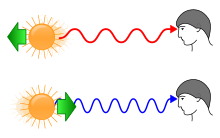
恒星や星間物質は銀河に重力的に束縛されており、銀河もまた銀河団に重力的に束縛されている[44]。天の川銀河内の天体や局所銀河群に属する銀河を除いて、ほとんどすべての天体は宇宙の膨張により地球から遠ざかっている。
ドップラー効果と赤方偏移
[編集]
天体がどのように動いているかを、スペクトルから決定する手法がある。天体からの光の波長がドップラー効果により伸び縮みすることで、観測者に向かってくる天体の光は短波長側にずれ︵青方偏移︶、反対に観測者から遠ざかっていく天体の光は長波長側にシフト︵赤方偏移︶する。青方偏移した天体の光は本来の色より青く見え、赤方偏移した天体の場合は本来より赤く見える。
観測者の視線方向に対する天体の速度︵視線速度︶と波長のシフト量の関係は、天体が発した際の本来の光の波長を 、シフト後に観測された波長を
、シフト後に観測された波長を 、天体の視線速度を
、天体の視線速度を 、光速を
、光速を とおき、
とおき、 を
を  、つまり青方偏移側におくと
、つまり青方偏移側におくと
 と表現される。赤方偏移した吸収線や輝線は、静止した天体のそれらよりも長波長側に現れる。1913年にヴェスト・スライファーは、アンドロメダ銀河の波長が青方偏移しており地球に向かっていることを発見したが、続いてほかの20個の銀河を分光観測したところ、4つを除きすべての銀河が地球から遠ざかっていることがわかり、その遠ざかる速度も算出された。エドウィン・ハッブルはこのスライファーのデータと自身が追加で観測したデータから、地球からより遠く離れた銀河ほどより速く地球から遠ざかっているというハッブル=ルメートルの法則を発見し、1929年に発表した[20][45]。
この法則は、視線速度︵あるいはハッブルフロー︶
と表現される。赤方偏移した吸収線や輝線は、静止した天体のそれらよりも長波長側に現れる。1913年にヴェスト・スライファーは、アンドロメダ銀河の波長が青方偏移しており地球に向かっていることを発見したが、続いてほかの20個の銀河を分光観測したところ、4つを除きすべての銀河が地球から遠ざかっていることがわかり、その遠ざかる速度も算出された。エドウィン・ハッブルはこのスライファーのデータと自身が追加で観測したデータから、地球からより遠く離れた銀河ほどより速く地球から遠ざかっているというハッブル=ルメートルの法則を発見し、1929年に発表した[20][45]。
この法則は、視線速度︵あるいはハッブルフロー︶ と地球からの距離
と地球からの距離 、それからハッブル定数と呼ばれる比例定数
、それからハッブル定数と呼ばれる比例定数 を用いて
を用いて
 と表される。また、赤方偏移の度合いは
と表される。また、赤方偏移の度合いは と呼ばれる以下の式で定義される量で表される[46]。
と呼ばれる以下の式で定義される量で表される[46]。
 、シフト後に観測された波長を
、シフト後に観測された波長を 、天体の視線速度を
、天体の視線速度を 、光速を
、光速を とおき、
とおき、 を
を  、つまり青方偏移側におくと
、つまり青方偏移側におくと
 と表現される。赤方偏移した吸収線や輝線は、静止した天体のそれらよりも長波長側に現れる。1913年にヴェスト・スライファーは、アンドロメダ銀河の波長が青方偏移しており地球に向かっていることを発見したが、続いてほかの20個の銀河を分光観測したところ、4つを除きすべての銀河が地球から遠ざかっていることがわかり、その遠ざかる速度も算出された。エドウィン・ハッブルはこのスライファーのデータと自身が追加で観測したデータから、地球からより遠く離れた銀河ほどより速く地球から遠ざかっているというハッブル=ルメートルの法則を発見し、1929年に発表した[20][45]。
この法則は、視線速度︵あるいはハッブルフロー︶
と表現される。赤方偏移した吸収線や輝線は、静止した天体のそれらよりも長波長側に現れる。1913年にヴェスト・スライファーは、アンドロメダ銀河の波長が青方偏移しており地球に向かっていることを発見したが、続いてほかの20個の銀河を分光観測したところ、4つを除きすべての銀河が地球から遠ざかっていることがわかり、その遠ざかる速度も算出された。エドウィン・ハッブルはこのスライファーのデータと自身が追加で観測したデータから、地球からより遠く離れた銀河ほどより速く地球から遠ざかっているというハッブル=ルメートルの法則を発見し、1929年に発表した[20][45]。
この法則は、視線速度︵あるいはハッブルフロー︶ と地球からの距離
と地球からの距離 、それからハッブル定数と呼ばれる比例定数
、それからハッブル定数と呼ばれる比例定数 を用いて
を用いて
 と表される。また、赤方偏移の度合いは
と表される。また、赤方偏移の度合いは と呼ばれる以下の式で定義される量で表される[46]。
と呼ばれる以下の式で定義される量で表される[46]。
| 波長による計算 | 周波数による計算 |
|---|---|
上記の式で観測された光の波長が で周波数が
で周波数が であり、本来天体が発した光の波長・周波数が
であり、本来天体が発した光の波長・周波数が と
と である。
zが大きくなるほど、天体は地球から遠く、より赤方偏移されている。2013年1月にハッブル・ウルトラ・ディープ・フィールドで見つかった銀河はzが12、距離にして約130億光年︵宇宙の年齢が約138.2億年︶とされているが[47][48][49]、2022年に東京大学の研究者らが発見したHD1はzが13.27とさらに大きく、距離は約135億光年とされている[50]。
ハッブル=ルメートルの法則とドップラー効果の式を組み合わせて
である。
zが大きくなるほど、天体は地球から遠く、より赤方偏移されている。2013年1月にハッブル・ウルトラ・ディープ・フィールドで見つかった銀河はzが12、距離にして約130億光年︵宇宙の年齢が約138.2億年︶とされているが[47][48][49]、2022年に東京大学の研究者らが発見したHD1はzが13.27とさらに大きく、距離は約135億光年とされている[50]。
ハッブル=ルメートルの法則とドップラー効果の式を組み合わせて
 という関係も得られる。
という関係も得られる。
 で周波数が
で周波数が であり、本来天体が発した光の波長・周波数が
であり、本来天体が発した光の波長・周波数が と
と である。
zが大きくなるほど、天体は地球から遠く、より赤方偏移されている。2013年1月にハッブル・ウルトラ・ディープ・フィールドで見つかった銀河はzが12、距離にして約130億光年︵宇宙の年齢が約138.2億年︶とされているが[47][48][49]、2022年に東京大学の研究者らが発見したHD1はzが13.27とさらに大きく、距離は約135億光年とされている[50]。
ハッブル=ルメートルの法則とドップラー効果の式を組み合わせて
である。
zが大きくなるほど、天体は地球から遠く、より赤方偏移されている。2013年1月にハッブル・ウルトラ・ディープ・フィールドで見つかった銀河はzが12、距離にして約130億光年︵宇宙の年齢が約138.2億年︶とされているが[47][48][49]、2022年に東京大学の研究者らが発見したHD1はzが13.27とさらに大きく、距離は約135億光年とされている[50]。
ハッブル=ルメートルの法則とドップラー効果の式を組み合わせて
 という関係も得られる。
という関係も得られる。
固有運動
[編集]
重力で束縛された天体は、重力源との共通重心を公転する運動も持つ。天体のこの運動の速度を固有速度︵英:Peculiar velocity︶といい、視線速度に影響を及ぼす。
ハッブル=ルメートルの法則に固有速度の寄与を考慮すると[51]
 としてトータルの速度が補正される。単純なハッブル=ルメートルの法則に基づき期待される赤方偏移は固有速度により不明瞭になるため、恒星や銀河のスペクトルを観測する際に混乱を引き起こす。例えば、おとめ座銀河団の大きさと形状は、銀河団を構成する銀河それぞれが大きな固有速度を持っていたため、科学的に非常に慎重に精査されてきた歴史がある[52]。
としてトータルの速度が補正される。単純なハッブル=ルメートルの法則に基づき期待される赤方偏移は固有速度により不明瞭になるため、恒星や銀河のスペクトルを観測する際に混乱を引き起こす。例えば、おとめ座銀河団の大きさと形状は、銀河団を構成する銀河それぞれが大きな固有速度を持っていたため、科学的に非常に慎重に精査されてきた歴史がある[52]。
 としてトータルの速度が補正される。単純なハッブル=ルメートルの法則に基づき期待される赤方偏移は固有速度により不明瞭になるため、恒星や銀河のスペクトルを観測する際に混乱を引き起こす。例えば、おとめ座銀河団の大きさと形状は、銀河団を構成する銀河それぞれが大きな固有速度を持っていたため、科学的に非常に慎重に精査されてきた歴史がある[52]。
としてトータルの速度が補正される。単純なハッブル=ルメートルの法則に基づき期待される赤方偏移は固有速度により不明瞭になるため、恒星や銀河のスペクトルを観測する際に混乱を引き起こす。例えば、おとめ座銀河団の大きさと形状は、銀河団を構成する銀河それぞれが大きな固有速度を持っていたため、科学的に非常に慎重に精査されてきた歴史がある[52]。
連星
[編集]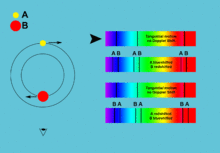
惑星が恒星に重力的に束縛されるように、連星もお互いの周りを公転している。
連星のうち実視連星と呼ばれるものは望遠鏡で互いを公転するそれぞれの星を分離して観測できる。しかし連星の中には恒星同士の距離が近すぎて分離して観測できないものもある[53]。こうした連星のうち、分光連星と呼ばれるものは、1つの星のスペクトルにもう1つのスペクトルが重なった特異なスペクトルを示すことで確認できる。この合成スペクトルは、両方の星の光度が近く、スペクトル分類が異なっているとより分かりやすくなる[54]。
分光連星はその視線速度によっても検出できる。お互いを公転する星は、片方が地球から見て近づいてくるとき、もう片方は遠ざかっていくが、このとき合成スペクトルにドップラー効果によるシフトが生じる。連星系の軌道平面によって、観測されるシフトの度合いは決定される。もし観測者が軌道平面に対し垂直な方向から観測していれば、視線速度は常に0となってしまい、この観測手法は使えない[53][54]。これは、メリーゴーラウンドを真横から観察すると、自分に近づいてくる馬と遠ざかっていく馬を観察できるが、真上から観察するとどの馬も観察者との距離が変わらずに動くことと同じである。
太陽系天体
[編集]
惑星・小惑星・彗星は皆、主星からの光を反射するが、同時に主星のスペクトルには含まれない独自の光も放射・吸収している。太陽系の惑星・小惑星といった比較的低温の天体の場合、放射のほとんどは肉眼では見えない赤外線だが、これらも分光観測では日常的に観測されている。彗星や大気を持つ惑星といったガスに包まれている天体の場合、その気体固有の波長で輝線・吸収線が生じ、こういったガス固有のスペクトルが天体の固体部分のスペクトルに刻まれる。中でも、金星や巨大ガス惑星、土星の衛星タイタンといった厚い大気や雲に覆われた天体の場合は、スペクトルは完全に大気部分のみに由来する[55]。
小惑星
[編集]
小惑星は、そのスペクトルから大きく分けると3種類に分類することができる。この分類は1975年にクラーク・チャップマン、デイヴィッド・モリソン、ベン・ゼルナーによって最初に考案され、1984年にデイヴィッド・トーレンによって拡張された。このトーレンの分類として知られる分類法では、炭素に富んだ小惑星はC型小惑星、ケイ酸塩質の小惑星はS型小惑星、金属質の小惑星はX型小惑星として分類されており、このほかにもさらに細かい分類や、これらに含まれない小惑星の分類が複数存在する。S型とC型が最も多くの小惑星を占める。
2002年にトーレンの分類はシェルテ・バスとリチャード・ビンゼルらによって、彼らが行ったより正確な小惑星のスペクトル観測をカバーするためにできるだけ原型を保ったままSMASS分類に拡張され、細かいものを含めて14個あった分類グループは26個にまで増加した[56][57]。
彗星
[編集]
彗星のスペクトルは、彗星の核を包むダストのコマが反射した太陽光と、太陽光や化学反応で励起した原子・分子からの蛍光による輝線の両方を含む。
たとえば、C/2012 S1 アイソン彗星の化学組成は分光法により決定され[58]、シアン︵CN︶や二原子炭素・三炭素︵C2 ・C3︶の顕著な輝線が検出された[59]。
近傍の彗星であれば、コマに向かって飛んでくる太陽風の荷電粒子が中和されるため、X線でも観測できる。そのため、彗星のX線スペクトルは彗星よりも太陽風の状態をよりよく反映している[60]。
太陽系外惑星
[編集]
太陽系外惑星からの反射光を、すぐそばに位置する主星からの光と分離して観測することで、特に岩石惑星の場合表面鉱物の吸収スペクトルなどが観測可能とされている。また、惑星が通過している最中の主星の光には、惑星大気の吸収スペクトルが含まれている。
現在多くの系外惑星が発見されており、その中にはホットジュピターと呼ばれるガス惑星や地球型惑星も多く含まれている。分光観測によってこうした惑星から、アルカリ金属や一酸化炭素、二酸化炭素、さらに水蒸気やメタンなどといった物質の存在が確認されている[61]。
関連項目
[編集]脚注
[編集]
(一)^ “天体分光学 - 天文学辞典”. 日本天文学会. 2022年12月9日時点のオリジナルよりアーカイブ。2023年1月30日閲覧。
(二)^ abcd
Foukal, Peter V. (2004). Solar Astrophysics. Weinheim: Wiley VCH. p. 69. ISBN 3-527-40374-4
(三)^ “Cool Cosmos - Infrared Astronomy”. California Institute of Technology. 2018年10月11日時点のオリジナルよりアーカイブ。2013年10月23日閲覧。
(四)^
Newton, Isaac (1705). Opticks: Or, A Treatise of the Reflections, Refractions, Inflections and Colours of Light. London: Royal Society. pp. 13–19
(五)^
Fraunhofer, Joseph (1817). “Bestimmung des Brechungs- und des Farben-Zerstreuungs - Vermögens verschiedener Glasarten, in Bezug auf die Vervollkommnung achromatischer Fernröhre”. Annalen der Physik 56 (7): 282–287. Bibcode: 1817AnP....56..264F. doi:10.1002/andp.18170560706.
(六)^ abcd
Hearnshaw, J.B. (1986). The analysis of starlight. Cambridge: Cambridge University Press. ISBN 0-521-39916-5
(七)^ ab
Kitchin, C.R. (1995). Optical Astronomical Spectroscopy. Bristol: Institute of Physics Publishing. pp. 127, 143. ISBN 0-7503-0346-8
(八)^ ab
Ball, David W. (2001). Basics of Spectroscopy. Bellingham, Washington: Society of Photo-Optical Instrumentation Engineers. pp. 24, 28. ISBN 0-8194-4104-X
(九)^ Barden, S.C.; Arns, J.A.; Colburn, W.S. (July 1998). d'Odorico, Sandro. ed. “Volume-phase holographic gratings and their potential for astronomical applications”. Proc. SPIE. Optical Astronomical Instrumentation 3355: 866–876. Bibcode: 1998SPIE.3355..866B. doi:10.1117/12.316806. オリジナルの2010-07-28時点におけるアーカイブ。 2019年9月12日閲覧。.
(十)^ Oke, J. B.; Gunn, J. E. (1983). “Secondary standard stars for absolute spectrophotometry”. The Astrophysical Journal 266: 713. Bibcode: 1983ApJ...266..713O. doi:10.1086/160817.
(11)^ Ghigo, F. “Karl Jansky”. National Radio Astronomy Observatory. Associated Universities, Inc.. 2013年10月24日閲覧。
(12)^ Pawsey, Joseph; Payne-Scott, Ruby; McCready, Lindsay (1946). “Radio-Frequency Energy from the Sun”. Nature 157 (3980): 158–159. Bibcode: 1946Natur.157..158P. doi:10.1038/157158a0. PMID 21015114.
(13)^ Ryle, M.; Vonberg, D. D. (1946). “Solar Radiation on 175 Mc./s”. Nature 158 (4010): 339–340. Bibcode: 1946Natur.158..339R. doi:10.1038/158339b0.
(14)^ Robertson, Peter (1992). Beyond southern skies: radio astronomy and the Parkes telescope. University of Cambridge. pp. 42, 43. ISBN 0-521-41408-3
(15)^ W. E. Howard. “A Chronological History of Radio Astronomy”. 2012年7月14日時点のオリジナルよりアーカイブ。2013年12月2日閲覧。
(16)^ “How Radio Telescopes Work”. 2013年12月3日時点のオリジナルよりアーカイブ。2013年12月2日閲覧。
(17)^ “Press Release: The 1974 Nobel Prize in Physics”. 2022年5月19日時点のオリジナルよりアーカイブ。2 December 2013 閲覧。
(18)^ “X線マイクロカロリメータ”. 2022年3月22日時点のオリジナルよりアーカイブ。2023年2月21日閲覧。
(19)^ ab
Jenkins, Francis A.; Harvey E. White (1957). Fundamentals of Optics (4th ed.). New York: McGraw-Hill. pp. 430–437. ISBN 0-07-085346-0
(20)^ ab
Morison, Ian (2008). Introduction to Astronomy and Cosmology. Wiley-Blackwell. p. 61. ISBN 978-0-470-03333-3. オリジナルの2013-10-29時点におけるアーカイブ。
(21)^ Gregory, Stephen A.; Michael Zeilik (1998). Introductory astronomy & astrophysics (4. ed.). Fort Worth [u.a.]: Saunders College Publ.. p. 322. ISBN 0-03-006228-4
(22)^ Pan, Liubin; Scannapieco, Evan; Scalo, Jon (1 October 2013). “Modeling the Pollution of Pristine Gas in the Early Universe”. The Astrophysical Journal 775 (2): 111. arXiv:1306.4663. Bibcode: 2013ApJ...775..111P. doi:10.1088/0004-637X/775/2/111.
(23)^
G. Kirchhoff (July 1860). “On the relation between the radiating and absorbing powers of different bodies for light and heat”. The London, Edinburgh, and Dublin Philosophical Magazine and Journal of Science (Taylor & Francis) 20 (130).
(24)^
Nahar, Anil K. Pradhan, Sultana N. (2010). Atomic astrophysics and spectroscopy. Cambridge: Cambridge University Press. pp. 7,221. ISBN 978-0-521-82536-8
(25)^
Mahmoud Massoud (2005). “§2.1 Blackbody radiation”. Engineering thermofluids: thermodynamics, fluid mechanics, and heat transfer. Springer. p. 568. ISBN 3-540-22292-8
(26)^
“Luminosity of Stars”. Australia Telescope National Facility (2004年7月12日). 2014年8月9日時点のオリジナルよりアーカイブ。2012年7月2日閲覧。
(27)^
Zwicky, F. (October 1937). “On the Masses of Nebulae and of Clusters of Nebulae”. The Astrophysical Journal 86: 217. Bibcode: 1937ApJ....86..217Z. doi:10.1086/143864.
(28)^
Romanowsky, Aaron J.; Douglas, Nigel G.; Arnaboldi, Magda; Kuijken, Konrad; Merrifield, Michael R.; Napolitano, Nicola R.; Capaccioli, Massimo; Freeman, Kenneth C. (19 September 2003). “A Dearth of Dark Matter in Ordinary Elliptical Galaxies”. Science 301 (5640): 1696–1698. arXiv:astro-ph/0308518. Bibcode: 2003Sci...301.1696R. doi:10.1126/science.1087441. PMID 12947033.
(29)^
Matthews, Thomas A.; Sandage, Allan R. (July 1963). “Optical Identification of 3c 48, 3c 196, and 3c 286 with Stellar Objects”. The Astrophysical Journal 138: 30. Bibcode: 1963ApJ...138...30M. doi:10.1086/147615. オリジナルのSeptember 26, 2017時点におけるアーカイブ。.
(30)^ ab
Wallace, P.R. (1991). Physics : imagination and reality. Singapore: World Scientific. pp. 235–246. ISBN 997150930X
(31)^
Rubin, Vera C.; Graham, J. A.; Kenney, Jeffrey D. P. (July 1992). “Cospatial counterrotating stellar disks in the Virgo E7/S0 galaxy NGC 4550”. The Astrophysical Journal 394: L9. Bibcode: 1992ApJ...394L...9R. doi:10.1086/186460.
(32)^
Kudritzki, R.-P. (May 2010). “Dissecting galaxies with quantitative spectroscopy of the brightest stars in the Universe”. Astronomische Nachrichten 331 (5): 459–473. arXiv:1002.5039. Bibcode: 2010AN....331..459K. doi:10.1002/asna.200911342.
(33)^ abcd
Kitchin, C.R. (1987). Stars, nebulae, and the interstellar medium : observational physics and astrophysics. Bristol: A. Hilger. pp. 265–277. ISBN 0-85274-580-X
(34)^ Hudson, Reggie L.. “The Interstellar Medium”. Goddard Space Flight Center Astrochemistry Laboratory. 2013年7月13日時点のオリジナルよりアーカイブ。2013年11月19日閲覧。
(35)^
Huggins, Sir William (1899). The Scientific Papers of Sir William Huggins. London: William Wesley and Son. pp. 114–115
(36)^ abc
Tennyson, Jonathan (2005). Astronomical spectroscopy : an introduction to the atomic and molecular physics of astronomical spectra ([Online-Ausg.]. ed.). London: Imperial College Press. pp. 46–47, 99–100. ISBN 1-86094-513-9
(37)^
Hirsh, Richard F (June 1979). “The Riddle of the Gaseous Nebulae”. Isis 70 (2): 162–212. Bibcode: 1979Isis...70..197H. doi:10.1086/352195. JSTOR 230787.
(38)^
Bowen, I. S. (1 October 1927). “The Origin of the Nebulium Spectrum”. Nature 120 (3022): 473. Bibcode: 1927Natur.120..473B. doi:10.1038/120473a0.
(39)^
Efremov, Yu. N. (22 February 2011). “On the spiral structure of the Milky Way Galaxy”. Astronomy Reports 55 (2): 108–122. arXiv:1011.4576. Bibcode: 2011ARep...55..108E. doi:10.1134/S1063772911020016.
(40)^
Shu, Frank H. (1982). The physical universe : an introduction to astronomy (12. [Dr.]. ed.). Sausalito, Calif.: Univ. Science Books. pp. 232–234. ISBN 0-935702-05-9
(41)^ Cami, J.; Bernard-Salas, J.; Peeters, E.; Malek, S. E. (22 July 2010). “Detection of C60 and C70 in a Young Planetary Nebula”. Science 329 (5996): 1180–1182. Bibcode: 2010Sci...329.1180C. doi:10.1126/science.1192035. PMID 20651118.
(42)^
Johansson, LE; Andersson, C; Ellder, J; Friberg, P; Hjalmarson, A; Hoglund, B; Irvine, WM; Olofsson, H et al. (1984). “Spectral scan of Orion A and IRC+10216 from 72 to 91 GHz”. Astronomy and Astrophysics 130: 227–56. Bibcode: 1984A&A...130..227J. PMID 11541988.
(43)^
Millar, TJ; DA Williams (1993). Dust and chemistry in astronomy. Bristol [u.a.]: Inst. of Physics. p. 116. ISBN 0-7503-0271-2
(44)^
“Hubble Pinpoints Furthest Protocluster of Galaxies Ever Seen”. ESA/Hubble Press Release 2012年1月13日閲覧。
(45)^
Haynes, Martha. “Hubble's Law”. 2022年6月12日時点のオリジナルよりアーカイブ。2013年11月26日閲覧。
(46)^
Huchra, John. “Extragalactic Redshifts”. California Institute of Technology. 2023年1月22日時点のオリジナルよりアーカイブ。2013年11月26日閲覧。
(47)^
Ellis, Richard S.; McLure, Ross J.; Dunlop, James S.; Robertson, Brant E.; Ono, Yoshiaki; Schenker, Matthew A.; Koekemoer, Anton; Bowler, Rebecca A. A. et al. (20 January 2013). “The Abundance of Star-Forming Galaxies in the Redshift Range 8.5-12: New Results from the 2012 Hubble Ultra Deep Field Campaign”. The Astrophysical Journal 763 (1): L7. arXiv:1211.6804. Bibcode: 2013ApJ...763L...7E. doi:10.1088/2041-8205/763/1/L7.
(48)^
“Hubble census finds galaxies at redshifts 9 to 12”. NASA/ESA. 2022年11月8日時点のオリジナルよりアーカイブ。2013年11月26日閲覧。
(49)^
“Planck reveals an almost perfect universe”. ESA (2013年3月21日). 2022年11月6日時点のオリジナルよりアーカイブ。2013年11月26日閲覧。
(50)^ “135億光年かなたの最遠方銀河の候補を発見”. アルマ望遠鏡. 2022年10月4日時点のオリジナルよりアーカイブ。2023年2月20日閲覧。
(51)^
“Peculiar Velocity”. Swinburne University of Technology. 2023年1月26日時点のオリジナルよりアーカイブ。2013年11月26日閲覧。
(52)^
Yasuda, Naoki; Fukugita, Masataka; Okamura, Sadanori (February 1997). “Study of the Virgo Cluster Using the B‐Band Tully‐Fisher Relation”. The Astrophysical Journal Supplement Series 108 (2): 417–448. Bibcode: 1997ApJS..108..417Y. doi:10.1086/312960.
(53)^ ab“Types of Binary Stars”. Australia Telescope Outreach and Education. Australia Telescope National Facility. 2013年12月8日時点のオリジナルよりアーカイブ。2013年11月26日閲覧。
(54)^ ab
Gray, Richard O.; Christopher J. Corbally (2009). Stellar spectral classification. Princeton, N.J.: Princeton University Press. pp. 507–513. ISBN 978-0-691-12510-7
(55)^
Goody, Richard M.; Yung, Yuk Ling (1989). Atmospheric Radiation: Theoretical Basis. New York, New York, USA: Oxford University Press. ISBN 0-19-505134-3
(56)^
Bus, S (July 2002). “Phase II of the Small Main-Belt Asteroid Spectroscopic Survey A Feature-Based Taxonomy”. Icarus 158 (1): 146–177. Bibcode: 2002Icar..158..146B. doi:10.1006/icar.2002.6856.
(57)^
Chapman, Clark R.; Morrison, David; Zellner, Ben (May 1975). “Surface properties of asteroids: A synthesis of polarimetry, radiometry, and spectrophotometry”. Icarus 25 (1): 104–130. Bibcode: 1975Icar...25..104C. doi:10.1016/0019-1035(75)90191-8.
(58)^ Sekanina, Zdenek; Kracht, Rainer (3 June 2015). "Disintegration of Comet C/2012 S1 (ISON) Shortly Before Perihelion: Evidence From Independent Data Sets". arXiv:1404.5968v6 [astro-ph.EP]。
(59)^ Knight, Matthew. “Why does ISON look green?”. Comet ISON Observing Campaign. 2013年12月3日時点のオリジナルよりアーカイブ。2013年11月26日閲覧。
(60)^
Lisse, C. M.; Dennerl, K.; Englhauser, J.; Harden, M.; Marshall, F. E.; Mumma, M. J.; Petre, R.; Pye, J. P. et al. (11 October 1996). “Discovery of X-ray and Extreme Ultraviolet Emission from Comet C/Hyakutake 1996 B2”. Science 274 (5285): 205–209. Bibcode: 1996Sci...274..205L. doi:10.1126/science.274.5285.205.
(61)^
Tessenyi, M.; Tinetti, G.; Savini, G.; Pascale, E. (November 2013). “Molecular detectability in exoplanetary emission spectra”. Icarus 226 (2): 1654–1672. arXiv:1308.4986. Bibcode: 2013Icar..226.1654T. doi:10.1016/j.icarus.2013.08.022.




